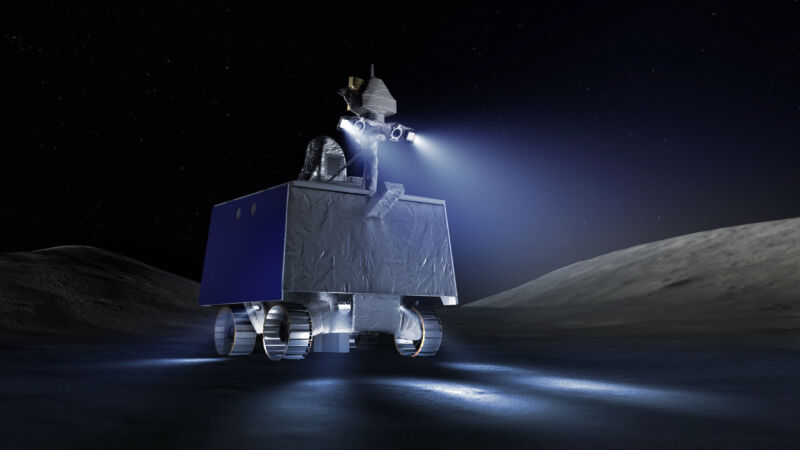
The search for ice at the moon’s poles has become big in the field of lunar science since an instrument on an Indian satellite discovered water molecules in shadowed crater floors more than a decade ago. NASA is now assembling a golf cart-sized rover to drive into the dark polar craters to search for ice deposits that could be used by future astronauts to make their own rocket propellant and breathing air.
“A large group of people have been working on this idea for more than 10 years,” said Anthony Colaprete, project scientist for NASA’s Volatiles Investigating Polar Exploration Rover (VIPER) mission.
Earlier this year, engineers at NASA’s Johnson Space Center in Houston began building the rover’s chassis. In June, the space agency formally cleared the VIPER team to proceed with full assembly and testing ahead of the rover’s planned November 2024 launch.
A new kind of robber
The four-wheeled rover looks different from NASA’s nuclear-powered robots that explore Mars. VIPER is designed to drive in dark craters, places where sunlight has not reached for billions of years. Scientists have found evidence that those cold, shadowed crater floors harbor water ice at or near the surface, where it could be harvested by astronauts.
“Because it goes to dark places, it’s the first rover with headlights,” Colaprete said in a presentation Tuesday at the NASA Exploration Science Forum. The LED headlights cast a blue hue on the charcoal moonscape.
VIPER will also be operated differently from NASA’s Mars rovers. It takes a radio signal between 5 and 20 minutes to travel at the speed of light between Earth and the red planet, but only a few seconds to make the journey to the moon. That means scientists can control VIPER more like a drone. “We’re doing real-time science,” Colaprete said.
The rover will make daring trips into the eternally dark craters, relying on battery power for up to 50 hours during each move that takes VIPER beyond the sun’s rays, always near the horizon at the lunar poles. The 1,000-pound (450-kilogram) rover will go into hibernation when the wobble of the moon’s rotation causes the south pole to shift out of Earth’s view for two weeks, cutting the direct communication link.
NASA announced the VIPER mission in 2019. VIPER builds on the Resource Prospector mission, which NASA canceled in 2018 when the agency moved to a commercial approach to robotic lunar exploration. That resulted in NASA’s Commercial Lunar Payload Services (CLPS) program, which lists companies eligible to bid for “task contracts” to carry scientific and engineering demo payloads to the moon.
One such company is Astrobotic, which NASA selected in 2020 to deliver VIPER to a landing site near Nobile Crater, a 45-mile-wide (73 kilometers) impact basin at the moon’s south pole. The approximately $200 million commercial supply agreement will allow Astrobotic to design and build the lander to carry VIPER to the Moon, a system that NASA would have developed — at a higher cost — for the original Resource Prospector mission.
Astrobotic selected SpaceX’s Falcon Heavy rocket to launch the company’s Griffin lander, which will guide the VIPER rover to the moon.
The entire mission is expected to cost about $500 million, including the rover, its science payloads and Astrobotic’s contract, which covers the cost of the Falcon Heavy launch.
“We’re trudging along,” Colaprete said Tuesday. “We are now less than a year away from supplying Astrobotic for integration on their Griffin lander. So the launch is in sight. Our nominal launch is November 10, 2024, with a mission duration of five months currently. We are looking at ways to extend that a month or two later.”
Two of VIPER’s three scientific instruments are already integrated into the vehicle in Houston. Next, the ground team attaches solar panels, four 20-inch (50-centimeter) wheels and a 3-foot (1-meter) long drill that will probe into the lunar surface to measure the depth of any ice deposits. A series of cameras will also be installed on the vehicle, as well as a mast that rises some 2.5 meters above the ground.
Water ice holds promise for space exploration. The hydrogen and oxygen could be used to generate electricity or rocket fuel, or converted to air to supply pressurized habitats on the moon. A NASA instrument on the Chandrayaan 1 orbiter mission in India first detected the telltale chemical signature of water at the moon’s poles in 2009.
But first, scientists need to know exactly where the water is and how easy it is to get to.
“We’re going to a place where there’s enhanced hydrogen,” Colaprete said. “Personally, I have no doubt that we will see water in some form, it’s just about the concentrations.”

